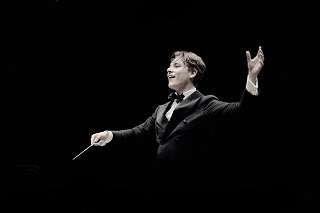|
Back
Klaus Mäkelä Shares a Transfigured Night New York
Isaac Stern Auditorium, Carnegie Hall
11/23/2024 - & November 18, 2024 (Orlando), March 31 (Vienna), April 2 (Hamburg), 2025
Arnold Schoenberg: Verklärte Nacht, Opus 4
Gustav Mahler: Symphony No. 1 in D Major
Royal Concertgebouw Orchestra, Klaus Mäkelä (Conductor)

K. Mäkelä (© Marco Borggreve)
“If you try to be anyone else when you’re holding a baton and you assume a different persona, it won’t work. A sense of authority can’t be created by external, artificial means.”
Klaus Mäkelä
“Music is only understood when one goes away singing it and only loved when one falls asleep with it in one’s head, and finds it still there on waking up the next morning.”
Arnold Schoenberg
I once asked a very esteemed Dutch conductor why, with Mahler’s German/Jewish/Austrian/Czech heritage, the only country which continuously, inevitably produced the most magical Mahler was Holland, especially the Royal Concertgebouw Orchestra (RCO).
His answer was unexpected.
“Ah,” he said, “you see we Dutch people are the most boring people anywhere in Europe. So when we come upon something exciting, like Gustav Mahler, we have to make it more exciting than anybody else.”
Which brings us to tonight’s performance by the RCO, led by one of the plethora of Finnish wunderkinder, Klaus Mäkelä. And briefly, the Mahler First Symphony, was not only youthful, warm, ethnic (do the Finns have a klezmer band??), buoyant and filled with the RCO dazzlements, but yes, the word “exciting” hardly begins to describe it.
One must understand that this First Symphony is not Goethe, not meditations on life and death, not a tragic Jewish/Christian two-hour homily on life and death. This was the 24‑year‑old genius conductor-composer spreading his youthful wings.
This was Mahler offering the sounds of the deep forest, going onto a small‑town Austrian ball, followed by a peasant funeral, and ending with a series of brassy fanfares.
I have little doubt that last night’s 27‑year‑old Maestro can handle later Mahler. But this performance was a joyride from the first bird‑peeps, to the offstage hunting trumpets, to wind ensembles which actually trembled.
Mr. Mäkelä was never afraid to push the instrumental entrances with his baton‑dagger, so horns and trumpets burst out of the orchestra like orchids popping open.
The conductor made his points in the second movement with equal physicality. His movements were not Bernstein exaggeration, but he did do the requisite broad‑arm leading, he kneeled when necessary, he once kicked up a foot. The result was more than rhythm unbound. It was Mahler having as much fun as in his ersatz “Funeral March.”
Not that this was a mere parade of dances. The second major theme is a sensitive rhapsody, and Mr. Mäkelä held the orchestra down. Not for a syrupy effect, but to bring utter clarity to the melody.
The Frère Jacques funeral movement is always fun, and Mr. Mäkelä even had the Jewish country band down to a T. That last movement? The RCO had nine or ten trumpets, a half‑dozen trombones and horns, the latter standing up for their finale–before the audience stood up en masse.

Royal Concertgebouw Orchestra (© RCO)
How lucky we New Yorkers are having the Berlin Philharmonic and the Royal Concertgebouw Orchestra in a single week. Though if I had my “druthers”, I would opt for the latter. Both orchestras have technical brilliance, both can whip through any music. But–and I realize that, in Shakespeare’s mock‑phrase, “Comparisons are oderous”–the RCO seems warmer, more personal. Mahler and Dvorák are both warmhearted works, but somehow the RCO transported the feeling throughout the hall.
The strings were given their own 30 minutes in the opening Schoenberg Transfigured Night. One didn’t need to know the short story–Two lovers stroll through a moonlit forest, she confesses she’s pregnant with another man’s baby, and he says, “Okay, no problem.”
Forgive my flippant re-narration. The huge RCO string orchestra told the story far better than I could imagine. The original, for string sextet is more private, more intimate. In Schoenberg’s arrangement for full orchestra, one feels the sweeping panorama of abstract music.
Mr. Mäkelä created what could only be called a Cubist painting. This was not merely the climax of the Romantic period. This was a sharp‑angled picture, the kind which painter Schoenberg might have executed. Except in the case of the RCO, those final moments, brought forth by Mr. Mäkelä lost its quality of a single historical period. It was a heavenly light in the cosmic darkness.
And for the first I can remember, the entire audience stood up. For Arnold Schoenberg?? The RCO produced not only musical miracles but for a jaded Manhattan audience, gave a truly transfigured night.
Harry Rolnick
|